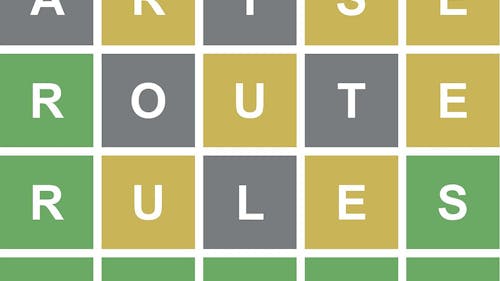What's with Wordle? Here's why your new favorite word game has exploded in popularity

Wordle is the simple word game that has cluttered social media with colored grids and phrases like “look at me! I got it in two!” have taken the world by storm. In November 2021, Wordle had 90 players. It now has more than 2.7 million. The sensationalization of the game really begs the question, “what makes this game so popular?”
Wordle was originally created by New York City software engineer Josh Wardle for his partner, Palak Shah, an avid fan of word games. In late January, it was bought by The New York Times for a price in the “low seven figures,” according to The Times. The Times plans for the game to remain free, at least in the interim.
The objective of the game is to correctly guess a designated five-letter word in six tries. After each guess, players are given feedback: The letter turns green if it’s the correct letter in the correct sequence, yellow if it’s the correct letter in the wrong sequence and gray if the letter isn't in the word at all.
Players must then use this feedback to continue guessing the word. Each day, one word is released. Once completed, players are given the option to share their results across different social media platforms.
Because it was designed specifically for Shah, there are no advertisements or monetization built into the game. In many ways, Wordle is the antithesis of most viral games. There are no tools to suck users in and keep them locked to a screen for hours.
In fact, the one puzzle released a day is a limiting factor in the game’s usage. You don’t have to sign up or volunteer personal information to play. Wardle claims it's these factors that make Wordle the success it is. In an interview with NPR, he explained, "the rejection of some of those things has actually attracted people to the game because it feels quite innocent, and it just wants you to have fun with it."
Psychologists have also taken to social media to explain the Wordle phenomenon. Board-certified psychologist Lee Chambers explained to Insider that the game strikes the perfect balance of engaging both the language and the logic processing parts of the brain. It triggers the release of dopamine or the “feel-good hormone” in the brain when you get a direct audiovisual response to your guesses.
Community is another essential point to the virality of the game. Amid a pandemic going on for more than two years, people are desperate for connection. Inherent to the game is the fact that everyone works on the same puzzle each day. This sparks both community and competition, two points of connection. The share option on Wordle has created countless Facebook groups and group chats dedicated to score sharing from just this one game.
Thi Nguyen, a philosophy professor at the University of Utah, shared on Twitter that he believes the genius of the game is in the graphics of the shareable wordle grid. “There's a huge amount of information — and drama — packed into that little graph,” he describes it as an “arc of decisions, attempts and failures.”
Ian Bogost, writer for The Atlantic believes the key to Wordle’s success is in its unoriginality. It's a concept similar to the age-old game, Mastermind, with components of crossword puzzles and several other preexisting word games. He claims the unoriginal design, the ritual comfort, the sharing mechanism and the fact that it’s simply a fun game are the keys to Wordle’s success.
We seem to live in a world that values novelty, innovation and individuality. Bogost claims true novelty is rarely successful — largely because it's uncomfortable. Successful novelty is usually derivative of preceding innovation. It creates advancement and modernization in increments we're comfortable with.
Wordle is not novel in any major way: It's a combination of logic and skills that the average human already uses. But it hit the nail right on the head in the way it innovated itself, creating the perfect Wordle storm.



